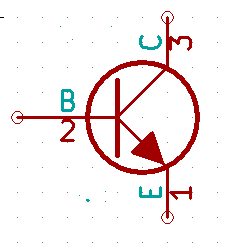While designing the electictrical system for Yeti I came across a whole host of thing that I didn’t understand from pull-up resitor to PNP. Guessing I probably wasn’t alone in this I thought I’d document at least some of them here. Keep in mind that I’m not an electrical engineer so this may not be the full picture but it should be enough to get you going.
Transistor
Transistors are essentially switches with no moving parts and they are essential to almost every modern electrical device. There are two main types, NPN and PNP, with the first being more commonly used. All transistors have three leads called base, collector and emitter (unless it’s a FET). The image below shows an NPN type transistor.

If a small current is applied at the base (flowing to the emitter) then a larger current is allowed to flow from the collector to the emitter.
Further Reading
- http://en.wikipedia.org/wiki/Transistor
- http://www.technologystudent.com/elec1/transis1.htm
- http://electronics.howstuffworks.com/transistor.htm
- http://www.electronics-tutorials.ws/transistor/tran_1.html
Pull-Up / Pull-Down Resistor
When working with digital circuits it is important that all inputs are clearly either a zero or a one (e.g. >4v for one and <1v for zero. If an input is not connected to anything it is said to be floating and in this situation it can randomly switch between a zero or a one as it’s voltage fluctuates. A pull-up resistor connects the unused input to the positive rail to provide a permanent one (e.g. it puts +5v on the input) a pull-down resistor connects the input to the ground rail to provide a permanent zero (e.g. it puts 0.5v on the input).
Further Reading
Source / Sink Current
Open Collector
PNP / NPN Sensor
Normally Open / Normally Closed
The terms normally open (abbreviated NO, N/O or N.O.) and normally closed (abbreviated NC, N/C or N.O.) refer to the state of the contacts in the switch or relay when in the default position. If the switch or relay default position means no current can flow then it is normally open, if the default position allows current to flow then it is normally closed. Some switches and relays support both normally open and normally closed wiring, these are called changeover or double-throw.
A normally open relay is called “Form A” and a normally closed “Form B”. Relays that support both NO and NC wiring are subdivided by whether they break one set of contacts before making the other. If the operation is break before make (also known as transfer) then it is Form C, if it make before break then it is Form D.